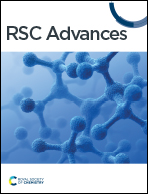Graphitized mango seed as an effective 3D anode in batch and continuous mode microbial fuel cells for sustainable wastewater treatment and power generation
Abstract
Herein, we explored the utilization of graphitized mango seeds as 3D-packed anodes in microbial fuel cells (MFCs) powered by sewage wastewater. Mango seeds were graphitized at different temperatures (800 °C, 900 °C, 1000 °C, and 1100 °C) and their effectiveness as anodes was evaluated. Surface morphology analysis indicated that the proposed anode was characterized by layered branches and micro-sized deep holes, facilitating enhanced biofilm formation and microorganism attachment. Maximum power densities achieved in the MFCs utilizing the mango seed-packed anodes graphitized at 1100 °C and 1000 °C were 2170.8 ± 90 and 1350.6 ± 125 mW m−2, respectively. Furthermore, the weight of the graphitized seed anode demonstrated a positive correlation with the generated power density and cell potential. Specifically, MFCs fabricated with 9 g and 6 g anodes achieved maximum power densities of 2170.8 ± 90 and 1800.5 ± 40 mW m−2, respectively. A continuous mode air cathode MFC employing the proposed graphitized mango anode prepared at 1100 °C and operated at a flow rate of 2 L h−1 generated a stable current density of approximately 12 A m−2 after 15 hours of operation, maintaining its stability for 75 hours. Furthermore, a chemical oxygen demand (COD) removal efficiency of 85% was achieved in an assembled continuous mode MFC. Considering that the proposed MFC was driven by sewage wastewater without the addition of external microorganisms, atmospheric oxygen was used as the electron acceptor through an air cathode mode, agricultural biomass waste was employed for the preparation of the anode, and a higher power density was achieved (2170.8 mW m−2) compared to reported values; it is evident that the proposed graphitized mango seed anode exhibits high efficiency for application in MFCs.



 Please wait while we load your content...
Please wait while we load your content...